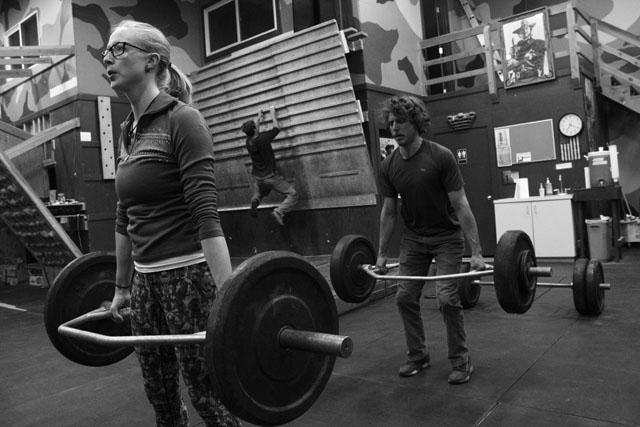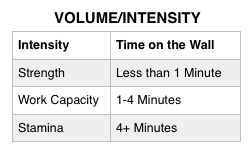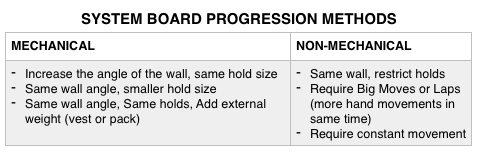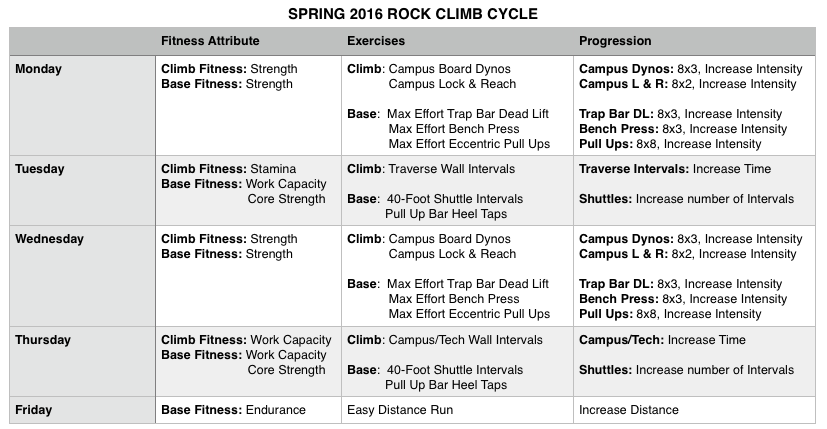
By Rob Shaul
Founder/Coach
Rock climbers have a constant, shifting imbalance between climbing fitness, and climbing technique.
Brand new climbers have a wide imbalance – they are plenty strong for the low rated climbs, but are limited by technique.
But soon, technique catches up, and the imbalance between fitness and technique becomes much more narrow.
Experienced climbers constantly battle this imbalance, not only in their general terms, but also on specific bouldering problems or routes.
Our sport-specific rock climbing climbing cycles are primarily focused on climbing fitness.
Most accomplished climbing coaches come from a climbing background. We are an exception – I’m not an accomplished climber by any means.
We’ve turned this into an advantage, brought new thinking to rock climb programming, and developed our own unique approach to climbing fitness training.
What is Climbing Fitness?
Ninety-five percent of it is finger/grip strength, work capacity and stamina. Upper body pulling strength is far less a determinate of climbing ability than one might think. We’ve seen this many times – women who struggle with simple pull ups, regularly outperform men on our system boards and out climb men on actual rock.
I’ve seen this natural lack of pulling strength almost become a climbing advantage for women. It forces them to climb with their feet and get their hips in closer to the wall. Hips close means more weight on the feet, and less on the fingers, which means more time on the holds before failing.
Body tension is another component of climbing fitness I’ve honestly struggled to identify, and similarly struggled to find progressable, gym-based exercises to train. On actual climbs, you’ll see body tension come into play when reaching for wide holds, or for contact strength on small holds or slopers. Some coaches use levers to train this, but I’m not convinced of the transfer to the actual sport. As a hole, however, body tension is not nearly as important to finger/grip strength for climbing performance.
As well, Base or general strength and fitness is not super important. We’ve had world class, national champion climbers in our gym for photo shoots, who struggled with simple push ups and squats, could barely do sprints or any cardio, and smoked outside between photo sets! But their fingers had re-bar like strength, and their forearms rivaled Popeye’s. They onsighted the hardest bouldering problems in the local climbing gym, no problem.
Increased total body strength certainly won’t hurt climbing performance – as long as it doesn’t result in excess muscle mass. Same for general fitness work capacity and endurance.
General fitness work capacity and endurance are also effective means of cutting body fat.
“Intensity” applied to Rock Climbing
When I began programming or rock climbing I first dove into published books and research. I found many climbing books which were exercise or routine heavy, but programming light. The few authors who did describe their programming approach use the number of hand movements as a way to determine intensity.
To understand this concept, I need to take you into the gym and use a barbell example.
In strength and conditioning terms, “intensity” means the load on the barbell.
The heavier the barbell, the higher the “intensity.”
And, if you’re just doing regular reps, the heavier the barbell, the few reps you can do, and thus, the less time you have under load, or ” tension.” This “time under tension” idea is important moving forward.
The rock climbing coaches I researched used the “number of hand movements” to determine intensity.
For example, if I climber could only make 5 or less hand movements on a series of holds, this was considered “strength” training. Five to fifteen hand movements could be considered “power endurance,” and 15+ hand movements would be considered “endurance.”
Now transfer this idea to a typical climbing gym. A hard bouldering problem (5 or fewer moves) would be a strength effort. A single pitch top roped climb at the limit of a climber’s ability would be a “power endurance” effort, and a multiple, consecutive laps up a top-roped route 2 or 3 levels below the climber’s ability would be an “endurance” effort.
With the exception of perhaps bouldering specialists, high level climbers will want to have high levels of fitness across these three levels of intensity – short strength efforts, longer power endurance efforts, and long endurance efforts. It’s entirely possible that a single, hard pitch could bring into play each of these attributes: a hard, intense 3-move “crux,” 8 move power endurance effort right after, and the entire pitch, a long 20-move endurance effort.
When I began training climbers, I tried to apply this hand-move methodology for determining intensity, but could never make it work consistently. When we tried to apply it in a rock gym, inevitably, the route setters would change things around just after we were able to find the right routes for the individual climbers, and we’d have to start from scratch. In my gym, on our own system boards, I also similarly struggled.
So early on, I abandoned this intensity methodology, and simplified things by using time under tension instead.
See the chart below:

Shifting away from counting hand movements to simply using time under tension has made all the difference for me as a coach, and allowed me to begin to apply the principles of fluid periodization, linear periodization, and progression to rock climb programming.
Strength efforts are short, hard and intense. We can use both timed intervals and campus dyno and lock and reach reps for progression. More and more I find I use the campus boards for our rock climb training.
Work capacity events are perhaps the most painful for our lab rats. These longer intervals on the wall should end intensely for the athletes. Often our athletes will be “chicken winging” – fighting to stay on at the end of the interval – you’ll see some of this in the videos below.
Stamina efforts are much longer, but not nearly as intense. In general fitness terms, these should feel like a long easy or moderately paced distance run.
System Boards Rule!
Frustrated by route changes in the local climbing gym, we finally committed to building our own climbing apparatus in our facility. For rock climbers, we further shifted away from graded routes, and went fully to system boards for climb-specific training.
We’ve experimented a lot with this over the years, and now have four system walls we deploy:
4) Campus Boards – Shallow boards with three sizes of rungs, “easy, moderate and hard,” – used for both strength (dynos, lock and reach) and work capacity training.
With a barbell, I can easily increase intensity by adding weight. It’s a little different for our climbing apparatus – where I have both “mechanical” and non-mechanical methods to increase intensity – See Chart Below:

Spring 2016 Rock Cycle Design
This six week cycle deploys our fluid periodization programming approach to train climbing specific strength, work capacity and endurance simultaneously, but with cyclic emphasis.
Specifically, this cycle emphasizes strength, and the athletes train climbing specific strength two days per week, and work capacity and endurance one day each, per week.
See the Chart Below:

Common Questions about this Cycle
If general fitness strength, work capacity and endurance are not super important for climbing fitness, how come you’ve got your athletes doing heavy trap bar dead lifts, shuttle sprints and a weekly long run?
The intensity of our grip/finger training is too high to keep them on the systems boards for the entire hour-long session. Since I don’t let my athletes linger in the gym, I have to feel this time up with something – hence the general fitness work. By combining the heavy trap bar dead lifts and bench presses with campus board dynos, I am able to give the athletes fingers a “rest” between campus board efforts and still train some total body strength. During Thursday’s work capacity efforts, by positioning the 40-foot shuttles between the system board work capacity intervals, I’m able to give their forearms a break and still keep them working hard. Finally, both the shuttle sprints and long run help cut fat.
Why Heavy Trap Bar Dead Lifts, Bench Presses and Weighted Eccentric Pull Ups for their General Fitness Strength work?
I wanted to include a simple lower body strength exercise (trap bar dead lift) in the cycle for overall “mountain chassis” strength development. The Trap Bar Dead Lift accomplishes this. The heavy upper body pressing exercise (bench press) helps balance all the natural pulling work they do on the system boards. Finally, the loaded, eccentric pull ups is a way to build pulling strength without excess mass. Going heavy with low volume (total reps) allows me to increase the athlete’s strength, without, hopefully, adding much excess muscle mass. Climbers need to be light.
Describe your Campus Board Dyno Progression
We have 3 levels of campus boards, divided by rung size. We did an initial assessment of 60 seconds total hand movements with feet on using our hardest (smallest rung) board the first day of this cycle, and I used this assessment to initially place athletes for their Campus dynos and lock and reaches. Campus boards train both pulling power (fast and explosive) and finger strength – but it’s the finger strength training which is most important. To dyno, the athlete’s fingers must be strong enough for the the press off the lower rung, and have enough contact strength for the “catch” on the upper rung. Keeping the focus on strength is important – and means I’m not interested in longish, cool looking dyno laps up and down the campus boards. Rather, I keep the reps to 3x, up/down, up/down, up/down. Once athletes can dyno up and down for three reps, skipping 2 rungs on one board, I move them up to the next hardest board. Some of my athletes are already on doing this on the hardest campus board, and instead of increasing reps, I’ll begin adding load – starting with 5 pounds – and keeping the reps per set to 3x. Campus boards are intense, and can be dangerous, especially on the drop back down. We use the campus board hangs in the warm up and the first 3 rounds of the campus dynos to “warm up” our athlete’s fingers and tendons.
How Long are your training sessions?
60 minutes – which is short compared to other coach’s programming. We’ve seen others with sessions lasting 2-4 hours – and have wondered if the coach who designed it had actually ever completed on of his or her own sessions! Few rock climbers actually “train” – most just go the bouldering or climbing gym and do the sport. As a result, the new lab rats in our gym are surprised by the intensity, how hard we push them, and how worked they are after a week of just 60-minute sessions. One of the things we’ve found is the hard intervals on our system boards not only train physical fitness, but also mental fitness. Athletes learn they can push and hold on much longer than they thought, and feedback has been that this mental edge pays huge dividends on the rock.
Specific Training Sessions
Below are examples of the specific training sessions in this cycle, and after the strength and work capacity sessions, is a representative video of the session.
Questions/Comments/Feedback?
Email rob@mtntactical.com
Want More?
Sign up for our next Webinar on programming for rock climbing here: https://attendee.gotowebinar.com/register/5562948667078841602
****************
Monday/Wednesday: Strength
Warm Up:
5/7 Campus Board Dead Hangs, 6 Reps each hold style. 5 sec hold, 7 sec rest
- Half Crimp
- Open Hand
- Full Crimp
- 3-Finger Open Hand
(1) 8 Rounds
- 3x Trap Bar Dead Lift (see loading below)
- 3x Campus Dyno
- Hip Flexor Stretch
Rnd Reps Load
1 5 50% 1RM
2 5 60% 1RM
3 5 75% 1RM
4-8 3 90% 1RM
(2) 8 Rounds
- 3x Bench Press (see loading below)
- 2x Campus Lock and Reach
- 5x Shoulder Dislocate
Rnd Reps Load
1 5 50% 1RM
2 5 60% 1RM
3 5 75% 1RM
4-8 3 90% 1RM
(3) 6 Rounds
- 3x Eccentric Pull Ups (Men loaded, women unloaded), 5-second drop
- 10x EO’s
Comments:
One of the rules I program by is not to give my athletes free time for mischief. The focus of today’s session is part (1)’s campus board dynos and part (2)’s campus board lock and reaches. Between these efforts the athletes need to rest their fingers. Instead I give them a “working rest” of some heavy trap bar dead lifts and bench presses, plus a stretch. The trap bar dead lifts and bench press don’t significantly impact their fingers, and allows me to work in some general fitness strength training during this cycle.
You’ll see the percentage based loading for the trap bar dead lifts and bench presses. We completed 1RM’s for these lifts the first session in this cycle and the athletes load accordingly. As well, we conducted a campus board assessment to determine where they began their dynos and lock and reaches for this progression. This assessment was simply total hand moves in 60 seconds, with feet on, using our hardest (smallest rungs) campus board. Athletes who scored 100+ hand moves on the assessment began their dynos and lock and reaches on our moderate campus board. Those who scored below 100 reps began on the easy campus board.
I’ve found over the years that climbing progression is much more fluid than general fitness progression. Climbing sessions demand focused coaching attention, and I’ll often increase or decrease climbing-specific intensity mid-session for individual athletes.
Campus boards are tricky, and the available literature for using them is limited to routines, not a systematic assessed and progressed methodology. This is the third cycle we’ve deployed them as main training tools, and I’m still developing our progression methodology. It will be the subject of a future article.
We finish this session with some heavy, eccentric pull ups. I won’t go into the details here, but we completed a max rep assessment – loaded at 25# for men, and unloaded for women, and developed a progression based upon the assessment. Over the course of the cycle, the volume will remain the same (6×3, 18 reps total), but we increase the load the athletes have in backpacks for their eccentric pull ups.
****************
Tuesday: Stamina
Warm Up:
5/7 Campus Board Shuffle, 5 sec hold, 7 sec rest
- Half Crimp
- Open Hand
- Full Crimp
- 3-Finger Open Hand
Training:
(1) 3 Rounds
- 2 minute Step Ups
- 3 minute Easy System Board
- 5 Minute Tech Board
(2) 7 Rounds
- 60 Sec 40-Foot Shuttle Reps
- 60 Sec Rest
(3) 5 Rounds
- 35% Pull Up Bar Heel Tap Reps
- 30/30 Side Bridge
Comments:
Part (1) is the focus of this session. Each round, the athletes spend 8 minutes on one wall or the other – 3 minutes on an easy System Board, then immediately 5 minutes on the harder Tech Board. I have to closely monitor my athletes during these intervals to adjust intensity. Stamina efforts shouldn’t end desperate – but rather be manageable by the athletes. These shouldn’t be super intense. If I see an athlete struggling, I can increase their step up time to decrease the total time on their hands, or increase their time on the system board to decrease the overall intensity of the 8 minute work interval.
At 3 rounds, Part (1) keeps the athletes on their hands for 24 total minutes – which is plenty early in the cycle. I fill the remainder of the 60 minutes in this session with some hard 40-foot shuttle intervals, and pull up bar heel tabs for core work. The second session in the cycle the athletes completed assessments for both exercises – a 5-minute 40-foot shuttle effort for reps, and a 60-second pull up bar heel tap effort for reps. I won’t go into the details here, but by doing the assessment, I’m able to scale these progressions to the incoming fitness of the individual athlete.
****************
Thursday: Work Capacity
Warm Up:
5/7 Campus Board Shuffle, 5 sec hold, 7 sec rest
- Half Crimp
- Open Hand
- Full Crimp
- 3-Finger Open Hand
Training:
(1) 4 Rounds
- 90 Second Tech Board, Constant Movement based on Assessment and A/B/C Holds
- 90 Second Step Ups
(2) 7 Rounds
- 60 Sec 40-Foot Shuttle Progression
- 60 Sec Rest
(3) 4 Rounds
- 90 Second Campus Board
- 90 Second Step Ups
(4) 5 rounds
- 35% Pull Up Bar Heel Tap
- 8x Ab Wheel
Comments:
Parts (1) and (2) are the climbing-specific parts of Thursday sessions. You’ll note the work interval for each – 90 seconds, nearly in the middle of our work capacity intensity. I use both campus boards (feet on) and our tech board for these efforts. These intervals should be intense – I see lots of chicken-winging! Over the years we’ve found that our programming not only trains grip and finger strength and fitness, but also the ability to recover fast from hard efforts.
